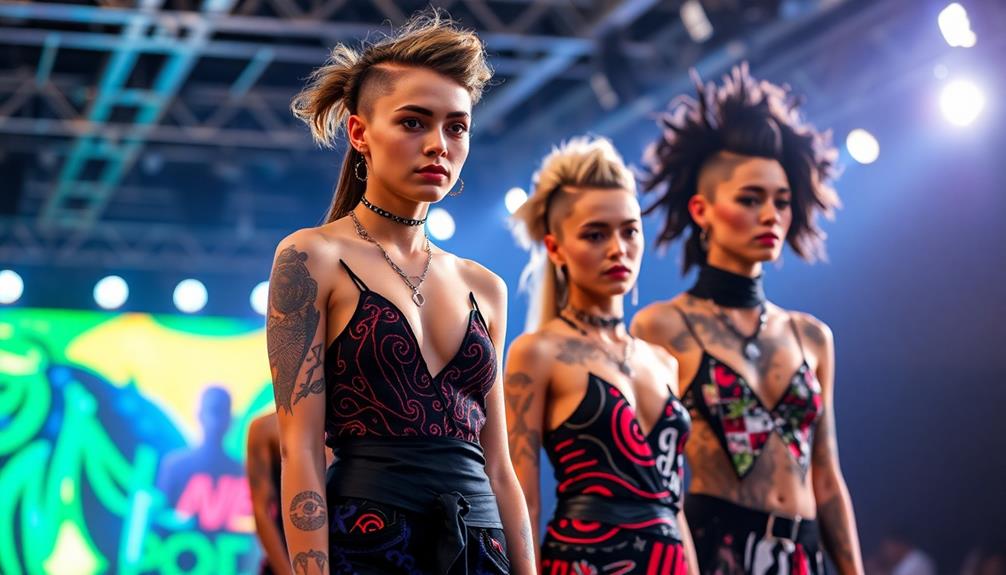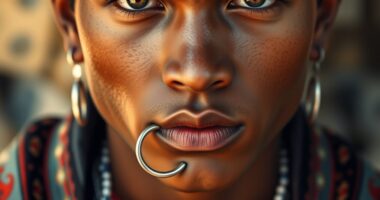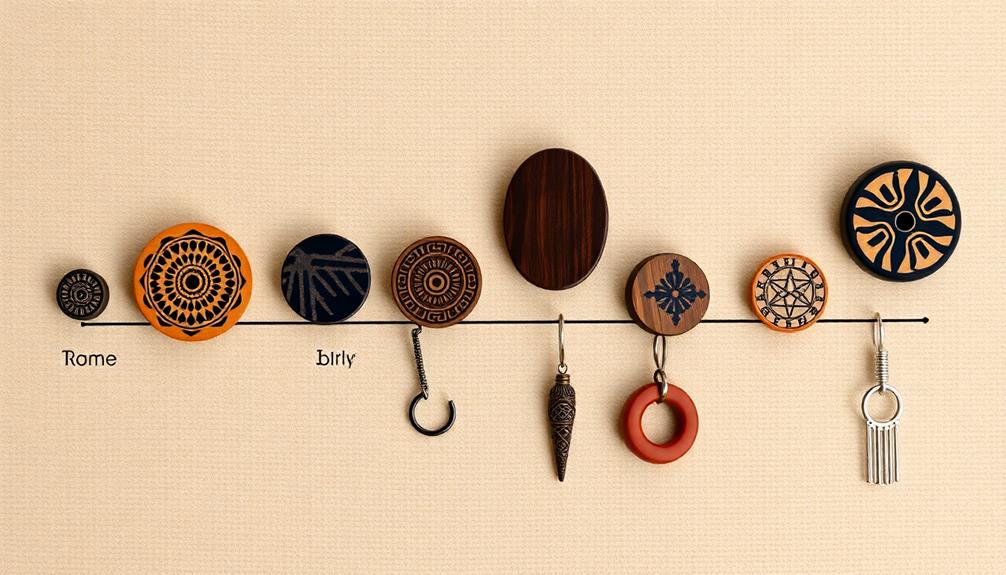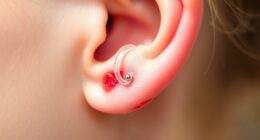In Victorian society, body piercings were often viewed through a complex lens. They symbolized wealth and nobility, especially among the elite, while also representing a rebellion against strict social norms. Nipple piercings gained popularity, influenced by Parisian trends, allowing women to express their identity despite societal scrutiny. However, the medical community raised concerns, linking piercings to promiscuity and moral decline. Over time, perceptions evolved, showcasing a clash between personal expression and societal expectations. This dynamic created a fascinating tension in Victorian culture. To uncover the nuances of this historical trend, you might want to explore further.
Key Takeaways
- Body piercings, particularly nipple piercings, were initially symbols of wealth and nobility among the upper class in Victorian society.
- The medical community viewed piercings as scandalous and raised health concerns, particularly regarding breastfeeding and hygiene.
- Nipple piercings challenged Victorian modesty norms, allowing women to assert their identity and rebel against societal expectations.
- Over time, piercings evolved from symbols of decadence to representations of personal freedom and self-expression across various social classes.
- Misconceptions linked piercings to promiscuity and moral decline, complicating public opinion and creating a tension between personal expression and societal norms.
Historical Context of Piercings

In Victorian England, body piercings, particularly nipple and genital piercings, were often seen as symbols of wealth and nobility. The upper classes showcased these piercings as marks of social status, flaunting their luxury through adornments crafted from gold and pearls. The trend gained traction in the late 19th century after its introduction from Paris, where such piercings became fashionable among the elite.
Despite their association with affluence, the medical community raised concerns about health risks linked to piercings. They deemed these practices scandalous, viewing them as inconsistent with the era's emphasis on modesty. While Victorian fashion typically promoted restraint, nipple piercings emerged as a bold form of rebellion, contrasting the public decorum expected of women.
Anecdotal evidence suggests that women who chose to engage in nipple piercings often faced societal scrutiny. Nevertheless, they embraced the practice not just as a statement of wealth, but also as a means of self-expression and identity.
This intricate interplay between societal norms and individual choice highlights how piercings served both as status symbols and personal declarations in a complex social landscape.
Symbolism and Social Change

In Victorian-era society, nipple piercings were once a bold statement of wealth and nobility, reserved for the upper class.
As hygiene improved and access broadened, these piercings transformed into symbols of personal freedom and rebellion against rigid social norms.
This shift reveals how body modifications can reflect deeper changes in identity and societal values over time.
Wealth and Nobility
Body piercings in Victorian-era society served as a powerful symbol of wealth and nobility, particularly among the upper classes. In this setting, nipple piercings became a bold statement of social status, showcased through low-cut blouses that highlighted a woman's sophistication and affluence. The trend signified more than just body adornments; it represented a distinct divide between the wealthy and the lower classes.
- Nipple and genital piercings were exclusive to high-born individuals.
- Such intimate piercings sparked envy among those who couldn't afford them.
- The wealthy used body piercings to express their elevated social status.
- Over time, the practice evolved into a broader form of self-expression across various classes.
As the trend became widespread, its meaning began to shift. What was once a mark of nobility slowly transformed, especially as the upper classes abandoned intimate piercings.
This change reflected evolving societal values, where piercings came to be associated with poverty and sexual promiscuity rather than prestige.
In the end, the journey of body piercings in Victorian England highlights the complexities of wealth, social status, and changing norms.
Rebellion and Identity
As the perception of body piercings evolved among the upper classes, they began to embody a provocative act of rebellion against the Victorian norms of modesty and decorum. Nipple piercings, in particular, challenged traditional expectations, allowing both men and women to assert their identity through body modifications. This act wasn't merely about aesthetics; it was a bold statement against the restrictive social norms of the Victorian era.
Influenced by the underground culture of Paris, nipple piercings became symbols of eroticism and decadence. For many, this was a way to express autonomy, revealing desires that clashed with public morality. Personal accounts from those who underwent this piercing reflect the tension between societal secrecy and their need for self-expression.
Women, in particular, found empowerment through these modifications, using them to reclaim their bodies and challenge the era's gender roles. By embracing body piercings, they sparked discussions about body autonomy and sexual liberation, pushing against the constraints imposed by Victorian culture.
Ultimately, nipple piercings served not only as acts of rebellion but also as profound statements of identity in a time of rigid social expectations.
Misconceptions Surrounding Piercings
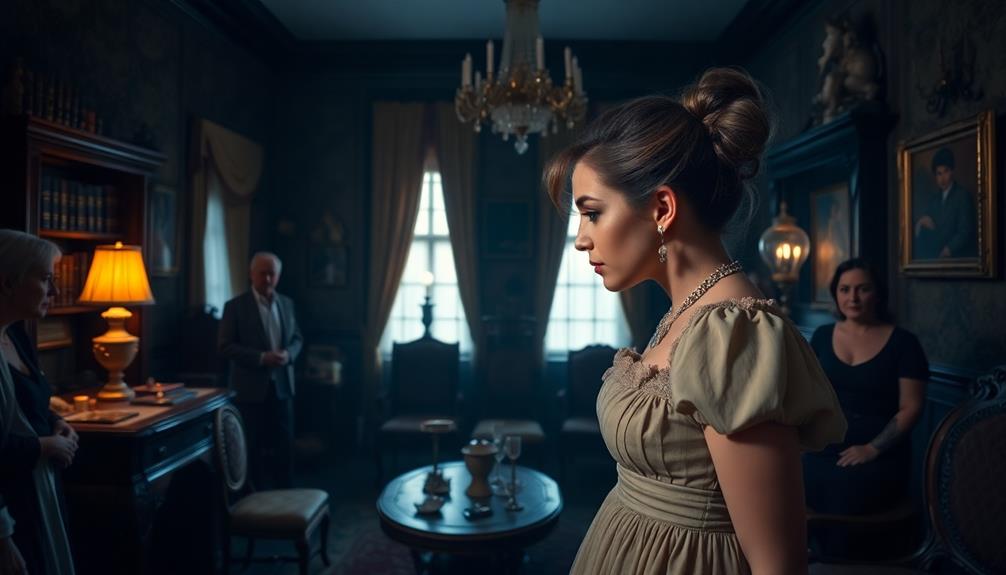
While many people today embrace body piercings as a form of personal expression, misconceptions surrounding these practices have deep roots in history, particularly during the Victorian era.
In that time, nipple piercings were often viewed as scandalous and linked to sexual promiscuity, despite being a symbol of wealth among the upper class. This perception was fueled by the opinions of medical professionals who raised health risks and societal norms as concerns.
Here are some key misconceptions from Victorian society:
- Nipple piercings indicated sexual promiscuity or moral decline.
- Pierced individuals were believed to engage in risky behaviors.
- Such body modifications challenged traditional views of femininity and masculinity.
- The practice was often associated with lower social status, despite its ties to wealth.
These misconceptions complicated public opinion, leading to a mix of fascination and disdain.
Gossip and societal debates further perpetuated these inaccurate views.
Curiously, research shows no significant behavioral differences between those with piercings and those without.
As societal attitudes evolve, it's clear that the historical stigma surrounding body modifications is gradually fading, making way for a more accepting perspective today.
Cultural Reflections of Piercings
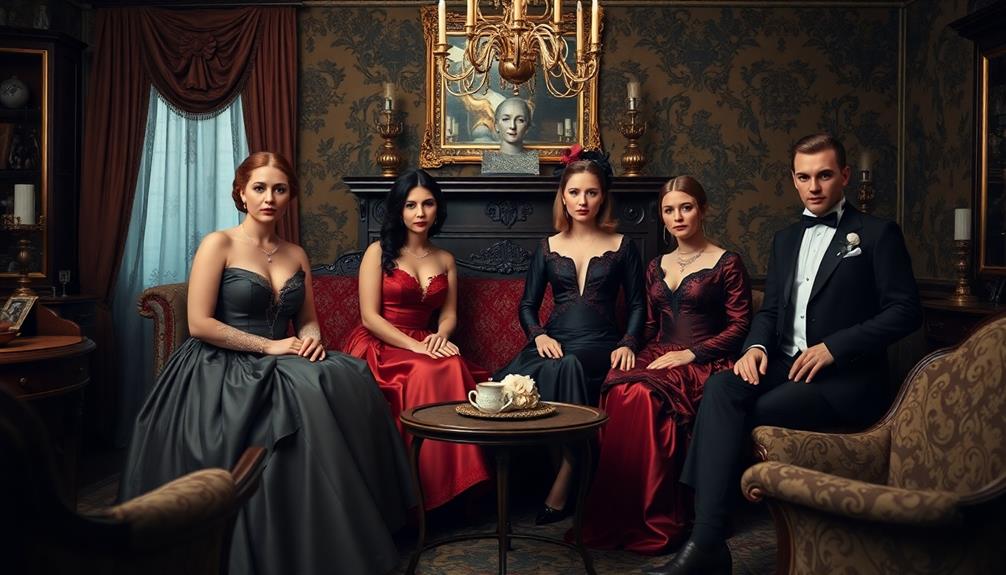
The misconceptions surrounding body piercings in Victorian society reveal a deeper cultural reflection of the era's values and social constraints. Nipple piercings, in particular, emerged as a provocative form of self-expression that challenged the rigid societal norms of femininity and sexuality. Originating in Paris, these piercings symbolized rebellion against the prevailing modesty, showcasing the tension between public morality and private desires.
| Aspect | Description | Cultural Significance |
|---|---|---|
| Self-Expression | Nipple piercings represented individual identity. | Challenged conformity and celebrated uniqueness. |
| Societal Norms | Reflects strict Victorian values on modesty. | Highlighted the clash between public and private. |
| Body Modification | Both men and women engaged in piercings. | Shifted gender norms and acceptance in social circles. |
| Underground Culture | Existence of erotic clubs contrasted public views. | Revealed hidden desires and rebellion against norms. |
Personal accounts illustrate the secrecy surrounding nipple piercings, revealing a complex social dynamic shaped by Victorian values. Ultimately, these piercings served as a subtle yet powerful form of body modification, allowing individuals to navigate their identities within the constraints of society.
Acceptance in Victorian Society
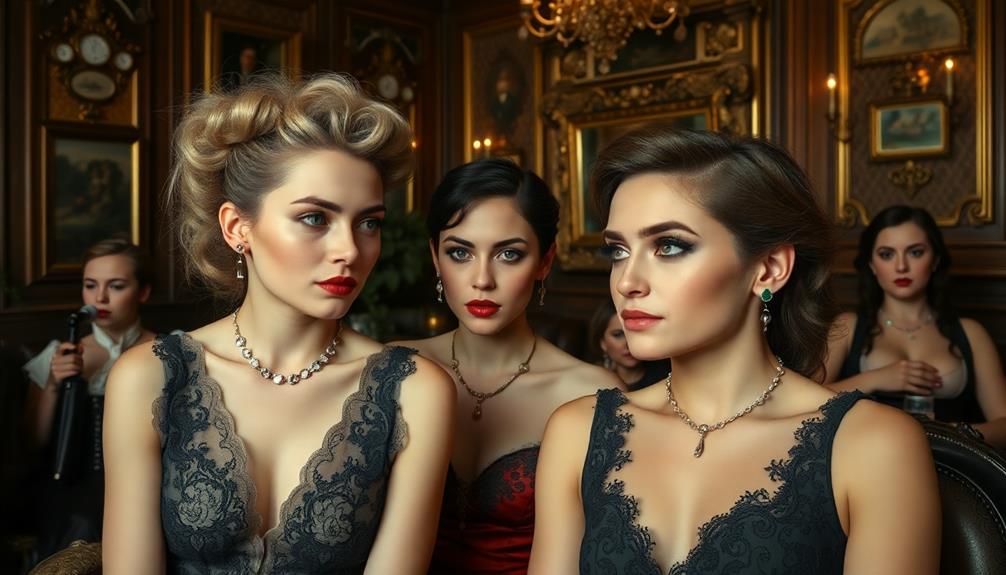
Challenging societal norms, nipple piercings found a unique position within Victorian society, oscillating between acceptance and scandal. While initially embraced by the upper class as a sign of wealth and decadence, these piercings also sparked debate over modesty and health risks.
Women showcased their nipple piercings through low-cut blouses, defying traditional expectations and marking a bold statement of social status.
- Nipple piercings became symbols of private indulgence against public morality.
- The trend started in Paris, influencing the elite in Victorian society.
- Men's involvement in nipple piercings challenged gender norms and added complexity to societal acceptance.
- The medical community raised concerns about health risks, especially regarding breastfeeding.
Despite their allure, nipple piercings carried an air of scandal, making them a double-edged sword.
Those who adorned themselves with these provocative pieces navigated a landscape filled with both admiration and criticism. For many, these piercings represented a rebellion against the stringent values of the time, embodying the tension between the desire for personal expression and the expectations of Victorian modesty.
Evolution of Nipple Piercing

Nipple piercings evolved considerably during the Victorian era, reflecting the shifting attitudes toward body modification and personal expression. This practice, once a mere curiosity, gained traction in Victorian society, largely influenced by trends from Paris. Those who had their nipples pierced often adorned them with gold rings connected by chains, making a bold statement against the era's strict social norms.
| Aspect | Description | Impact |
|---|---|---|
| Popularity | Nipple piercings became a trend among higher classes | Challenged modesty and decorum |
| Gender Participation | Both men and women embraced the practice | Showed a collective rebellion against norms |
| Medical Concerns | Medical professionals warned of health risks | Highlighted tensions between expression and safety |
These piercings became a provocative symbol of sexual liberation, allowing individuals to explore their desires amidst a culture that often stigmatized such expressions. Personal accounts reveal a blend of secrecy and fascination, as people navigated the taboo nature of nipple piercings. Ultimately, the evolution of nipple piercings in Victorian society illustrates a complex interplay between personal expression and the constraints imposed by societal expectations.
Modern Perspectives on Piercings
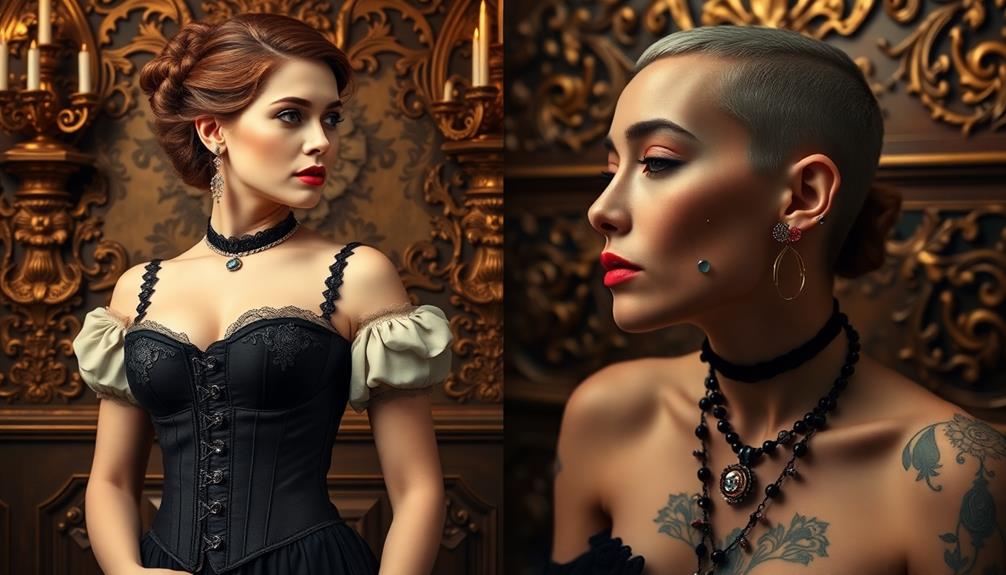
Nowadays, many people see body piercings as a vibrant form of self-expression rather than something scandalous. Unlike the Victorian era, where piercings were linked to rebellion and social stigma, contemporary culture embraces them as art and a celebration of individuality.
The rise of social media has greatly contributed to this shift, allowing you to share your unique piercing experiences and connect with others who share your passion.
In today's world, you'll find a diverse range of piercing styles, reflecting personal identity and aesthetic preferences.
Here are some modern perspectives on body piercings:
- Self-expression: Piercings are a way to showcase your personality.
- Artistic freedom: Various styles allow for creativity and unique designs.
- Health and safety: Professional studios prioritize hygiene, making piercings safer than ever.
- Community building: Social media platforms foster connections among piercing enthusiasts.
This evolution highlights how society now recognizes body piercings for their beauty and significance, transforming them from symbols of scandal to celebrated expressions of who you are.
Frequently Asked Questions
Were Piercings Popular in the Victorian Era?
Yes, piercings were popular in the Victorian era, especially among the upper classes. They embraced nipple piercings as symbols of luxury and rebellion, challenging societal norms while expressing personal style and sexuality.
What Is the Cultural History of Body Piercing?
Imagine scrolling through Instagram, seeing body piercings everywhere. Historically, they've symbolized rebellion and identity, evolving from tribal customs to modern fashion statements, reflecting cultural shifts and personal expression across diverse societies throughout the ages.
When Did Body Piercings Became Popular?
Body piercings became popular in the late 20th century, especially with the rise of punk culture and alternative movements. You might find various styles today, from earlobes to more daring placements, reflecting personal expression and identity.
When Did People Start Piercing Their Nipples?
People started piercing their nipples in the late 19th century, particularly around 1889. This trend emerged from Paris, where individuals embraced it as a bold form of self-expression, challenging conventional norms of their time.
Conclusion
In the Victorian era, body piercings danced on the edge of scandal and intrigue, revealing a society grappling with changing values. While some viewed them as taboo, others saw them as a bold statement of individuality. As perspectives evolved, so did the acceptance of piercings, paving the way for modern interpretations. Today, they're celebrated as expressions of personal identity, proving that what once raised eyebrows can now turn heads in admiration, highlighting the ever-shifting tide of cultural norms.


